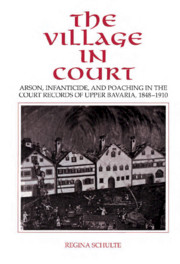 The Village in Court
The Village in Court Book contents
- Frontmatter
- Contents
- Acknowledgments
- Introduction: The breakup of the village
- PART I PEASANT SOCIETY AND THE INDIVIDUAL
- 1 Fire in the village
- 2 The mad-doctor's gaze
- PART II THE STATUS OF WOMEN AND THE PLACE OF CHILDREN
- PART III THE DISPUTED BOUNDARIES OF THE VILLAGE
- Conclusion: On the threshold between two worlds
1 - Fire in the village
from PART I - PEASANT SOCIETY AND THE INDIVIDUAL
Published online by Cambridge University Press: 04 May 2010
- Frontmatter
- Contents
- Acknowledgments
- Introduction: The breakup of the village
- PART I PEASANT SOCIETY AND THE INDIVIDUAL
- 1 Fire in the village
- 2 The mad-doctor's gaze
- PART II THE STATUS OF WOMEN AND THE PLACE OF CHILDREN
- PART III THE DISPUTED BOUNDARIES OF THE VILLAGE
- Conclusion: On the threshold between two worlds
Summary
Farms and small holdings had gone up in flames: straw stacks and hay barns, some peat huts and piles of brushwood, and particularly the barns packed with hay, straw, and the entire harvest, from where the fire would spread in an instant to the rest of the farm, so that in more than half the cases all the farm buildings and their contents had been reduced to ashes. The barn, with its store of dry fodder and grain, was the easiest part of the farm to set fire to. With stables, sheds, barn, wagon shed, and living quarters all under one roof, setting fire to the barn frequently resulted in the destruction of the farmhouse as well as the outbuildings, which, as often as not, was probably the intention. For everyone knew from experience the danger of fire in the hay, especially when the wind blew the sparks up onto the roof, which in the nineteenth century was often thatched with straw. By then it was too late for the fire brigade and for the neighbors rushing to help.
Fires were often due to arson. The cases described in Part I are not studied mainly for their legal or criminal content but regarded as a probe, illuminating conflicts central to peasant society. The “collecting of evidence” is not intended to apprehend a culprit, as the village policemen did, or to demonstrate the pathology of individual criminals within an otherwise small, comprehensible, and orderly world, as the psychiatry of the day attempted to do.
- Type
- Chapter
- Information
- The Village in CourtArson, Infanticide, and Poaching in the Court Records of Upper Bavaria 1848–1910, pp. 25 - 57Publisher: Cambridge University PressPrint publication year: 1994
